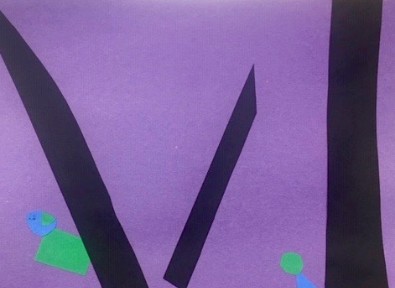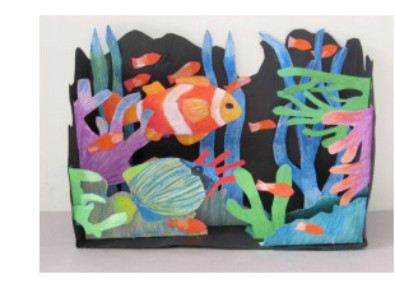Fourth Grade Art Kits - Descriptions & Links to Lesson Plans
36 Views of Mendenhall Glacier
36 Views of Mendenhall Glacier
Students are inspired Hokusai’s 36 Views of Mt. Fuji. They create their own view of the Mendenhall Glacier using Mark Kelley’s photos. Watercolor pencil painting techniques are used as students learn about contour lines, shading, background, middle ground, foreground, and the importance of contrast, to create their view of the glacier.

Action Figure Collage
Action Figure Collage
Students look at and learn about the collages of contemporary artist Miriam Schapiro. Students use a mannequin to draw and create a colorful paper collage “action figure,” showing themselves doing something they enjoy. They give credit to the person who taught them this skill.

African Painted Walls
African Painted Walls
Students ‘travel’ to the region of Burkina Faso in Western Africa to learn about the well-known painted houses. After studying the artists and their work, students create a narrative wall painting using cut silhouettes and paint. They incorporate patterns and traditional or personal symbols into their work.

Alaska Postcards
Alaska Postcards
In this indoor lesson,students mimic the art of painting outdoors, “plein air painting”. They learn to show “perspective” in a landscape and, using special paintbrushes which hold water, they make a small watercolor sketch landscape of a region of the Alaska. These can be used as postcards.
.

Alaskan Landscapes with Georgia O'Keeffe
Students study the life and art of Georgia O’Keeffe, focusing on her landscape painting. They create cut paper and oil pastel landscapes working from photos of Alaska.

Alutiiq Masks
Alutiiq Masks
Students learn the amazing story of the rediscovered masks from Kodiak Island, Alaska. They create a paper mask that explores 3 dimensions, simulates being made of wood, and includes traditional features. They present their mask as a museum exhibit.

Athabascan Beading
Athabascan Beading
Students look at Athabascan beading samples and decide if they were made “before contact” or “after contact,” to re-enforce the concept of changes occurring in the lifestyle of the Athabascan people after contact with foreigners who into the interior. Students learn simple beading technique and bead a sampler of either a flower pattern or a caribou pattern.

Book Binding: Nature Books
Students are introduced to the ancient and still vibrant art of book binding. The lesson guides them through steps to fold and sew pages into a binding, and create a nature- themed cover. The teacher can choose to add more pages and change the theme of the cover.

Clay Faces
Clay Faces
In this simple clay lesson, students learn about a local artist who experiences disabilities. They are inspired by her style of creating expressive faces from clay and create their own "series" of faces which show emotion and expression. Students learn clay techniques of hand building with "slabs" and joining clay with scoring and using "slip." Students clay faces can be fired in school kilns and then used by students for story telling/writing about their characters.
-z5a2f6.jpg)
Constructing Characters
Constructing Characters
Students used lines and shapes to build the bodies, heads, arms and legs of characters. This style of “constructive drawing” is used by cartoon artists. They added many unique details to show the personality of their character.

Cut Paper Pictures
Cut Paper Pictures
Students learn to use the four artist tools of color, shape, size and space to change the meaning of simple cut paper pictures. They create a "scene" that shows an event. The resulting picture primes them for writing a narrative of before, during and after this scene, complete with characters, setting and details.

Drawing from Observation
Drawing from Observation
Aquatic Insects: Students slow down and follow the details and fine lines of their subject. Drawing as careful observers, they learn about their subject as they go. They learn cross-hatching techniques for adding value and use these as they finish their drawing with a fine point black pen.

Drawing from Observation: Fossils
Drawing from Observation: Fossils
This lesson engages the students in artful thinking around a facinating fossil themed painting, leading them to curiosity around fossils. The class set of fossils provided in the kit allows kids the opportuntity to study and draw, building knowledge and developing q
-gy9qm0.jpg)
Drawing from Observation: Teeth and Jaws
Drawing from Observation: Teeth and Jaws
As student draw local animal teeth they consider the how the structure gives clues to the the animals eating habits and survival. Students compare their drawings to an "herbivore/onmivore/carnivore chart to determine more information about the animal. The class set of teeth and jaws must be borrowed from Discovery Southeast for this lesson. (Easy to do!)

Erosion and Deposition: Science, Drama and Art
Erosion and Deposition: Science, Drama and Art
A STEAM partner lesson to the Erosion and Deposition with Stream Tables Science Kit. Students use Thinking Routines to learn about Erosion and Deposition patterns through visual art pieces and local photographs. They then engage in a simple and well-structured drama experience that brings home the different erosion and deposition pattern of a landslide and a flood.

Giant Steps: Art and Jazz
Giant Steps: Art and Jazz
Students are inspired by a brief lesson in jazz history. They are introduced to the music of John Coltraine. Students recognize similarities in jazz music and art. They create mixed media art, combining painted watercolor shapes with scratch-foam block printing.

Hokusai Insect Prints
Hokusai Insect Prints
Students learn about the Japanese printmaker Katsushika Hokusai, best known for his print “The Great Wave Off Kanagawa”. They will create Japanese children’s style prints from collage (called a “collograph”), using insects as imagery.

Invent and Draw a Robot
Invent and Draw a Robot
Students learn about the Japanese printmaker Katsushika Hokusai, best known for his print “The Great Wave Off Kanagawa”. They will create Japanese children’s style prints from collage (called a “collograph”), using insects as imagery.

Ocean Life Diorama
Ocean Life Diorama
Students create a coral reef marine habitat complete with all the components that live in the habitat using oil pastels and construction paper.

Paper Quilts
Paper Quilts
Students work in small cooperative groups to agree on a set of artistic “rules” regarding a species of butterfly. Each child then makes a cut paper collage that follows those rules, and the group presents their unique, but similar artworks in a group “paper quilt.”

Raven Sculptures with John Hoover
Raven Sculptures with John Hoover
Students learn about Alaskan Aleut sculptor John Hoover and study two of his raven sculptures, looking for shape and texture. After learning interesting scientific facts about ravens, they draw and cut raven sculpture mobiles.

Salmon Summer in Kodiak
Salmon Summer in Kodiak
Through the book Salmon Summer in Kodiak, students learn about an Aleut boy who lives on Kodiak Island and fishes for salmon. Students create a 2D painting with warm or cool colors and incorporate designs inspired by salmon and traditional Aleut hunting hats.

Shells with Georgia O'Keeffe
Shells with Georgia O'Keeffe
Students learn about the life and art of Georgia O’Keefe, focusing on her large, close-up paintings of shells. They play an observation game of hunting for shape, pattern, and texture on photos of real shells, and then they use oil pastels to create a four-section study of actual shells.

Soap Carving
Soap Carving
Students learn about Unangan artist, Gertrude Svarny, from Unalaska. She carves soapstone, wood, ivory and other materials, creating “subtractive sculptures.” Students carve a small sculpture out of ivory soap. Bars of soap, patterns and tools are included to ensure student success.
